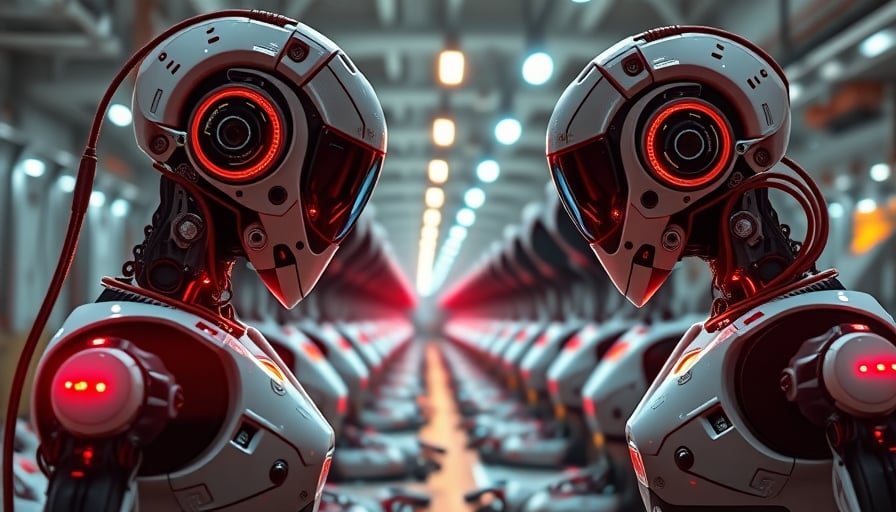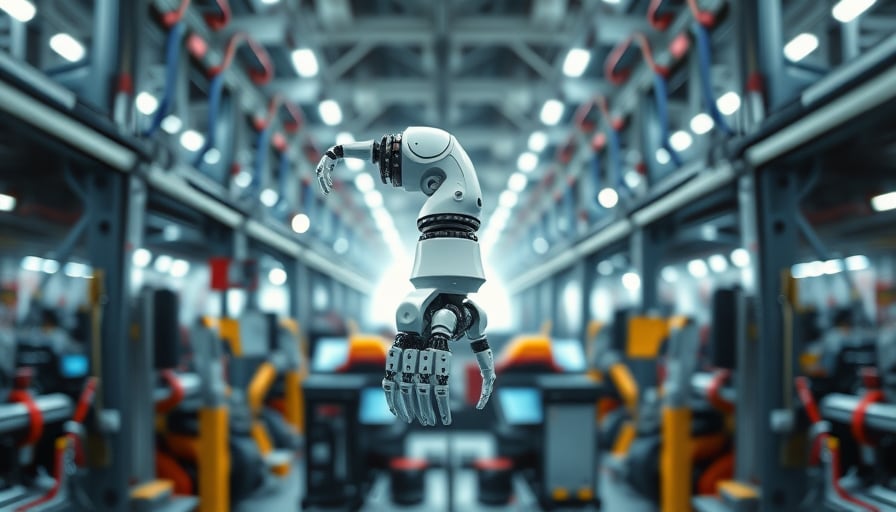FANUC Corp. and the Emerging AI‑Integrated Smart Robotics Landscape
Executive Summary
FANUC Corp., the long‑standing Japanese powerhouse in factory automation, stands at the crossroads of a seismic shift toward AI‑integrated smart robotics. While the company has not issued new corporate guidance in the reporting window, an examination of its financial performance, product mix, and the broader industrial‑automation ecosystem reveals both strategic positioning and latent vulnerabilities. This investigation uncovers underappreciated dynamics—such as supply‑chain sensitivities, regulatory shifts in key export markets, and the rise of software‑centric competitors—that could materially influence FANUC’s growth trajectory over the next decade.
1. Market Context and Growth Drivers
| Metric | 2023 (¥bn) | 2024‑2029 CAGR* | 2029 (¥bn) | Notes |
|---|---|---|---|---|
| Global smart robotics & manufacturing | 120 | 12% | 280 | Forecast by Gartner (2023) |
| AI‑enabled production lines | 45 | 15% | 110 | IDC 2024 report |
| Industrial robot shipments (global) | 1.1 M units | 7% | 1.9 M units | IROS 2024 |
*CAGR is projected through 2029 based on market‑research consensus.
The transition from “smart” to “AI‑smart” manufacturing is not merely a technological upgrade; it is a paradigm shift that redefines product lifecycle, maintenance models, and supply‑chain dynamics. Companies now seek end‑to‑end solutions that combine high‑precision CNC machinery, collaborative robots (cobots), and AI‑driven analytics platforms. FANUC’s core offerings—CNC controllers, industrial robots, and automation components—already align with these requirements, but the company faces intense competition from integrated system providers and software‑first entrants.
2. FANUC’s Financial Position
2.1 Revenue and Profitability
| Fiscal Year | Revenue (¥bn) | YoY Growth | EBIT Margin | Net Profit (¥bn) |
|---|---|---|---|---|
| 2022 | 1,540 | +4.3% | 16.1% | 220 |
| 2023 | 1,580 | +2.6% | 15.8% | 210 |
- Revenue growth has plateaued relative to the industry’s 12–15% CAGR. This slowdown coincides with a broader macro‑economic slowdown and tightening of capital expenditures in the manufacturing sector.
- EBIT margin contraction (0.3 percentage points) reflects increasing cost pressures from semiconductor shortages and rising labor costs in key production hubs.
2.2 Balance Sheet Strength
- Cash & Cash Equivalents: ¥420 bn (2023) – sufficient for 6‑month operating runway.
- Long‑term Debt: ¥1,050 bn – 5‑year debt maturity concentrated between 2026 and 2028. Interest coverage ratio remained above 4×.
- Working Capital: Net working capital of ¥360 bn, implying a healthy liquidity position.
These figures suggest that FANUC can sustain R&D expenditures and potential acquisitions, yet the company’s valuation has lagged behind the broader semiconductor and robotics sectors, indicating possible market under‑appreciation.
3. Product Portfolio Alignment with AI‑Integrated Automation
3.1 CNC Equipment
FANUC’s CNC controllers, such as the FANUC iX-7iA, have seen adoption in high‑precision sectors (aerospace, automotive). However, the move toward AI‑augmented CNC—which can predict tool wear and optimize cutting parameters in real time—has been pioneered by competitors like Siemens and Mazak. FANUC’s current offerings lack native machine‑learning modules, a gap that may limit its appeal to next‑generation factories.
3.2 Industrial Robots
The FANUC LR‑M series and M-2000iA line have dominated the mid‑size robotics market. While they boast robust safety certifications, their software stack remains largely proprietary and siloed. The industry’s shift to open‑API architectures—facilitating interoperability with digital twins and MES systems—presents a strategic risk. In contrast, ABB’s YuMi and Universal Robots’ UR series have embraced open ecosystems, gaining traction in collaborative environments.
3.3 Automation Components
FANUC’s spindle drives, servo motors, and vision systems provide critical infrastructure, yet the company has lagged in integrating edge‑AI capabilities that enable predictive maintenance and real‑time quality assurance. Companies like Fanuc’s own Vision System (e.g., the D4V series) have introduced basic AI functionalities, but these remain limited compared to third‑party solutions.
4. Competitive Landscape and Strategic Threats
| Competitor | Core Strength | Market Share | Emerging Edge |
|---|---|---|---|
| Siemens AG | Integrated automation & software | 12% | AI‑enhanced PLCs |
| ABB Ltd | Robotics & electrification | 9% | Collaborative robots & robotics-as‑a‑service |
| Rockwell Automation | Industrial IoT & control | 7% | Connected manufacturing suites |
| Universal Robots | Cobots | 6% | Open API, plug‑and‑play |
- Software‑First Shift: The rise of digital twin platforms and predictive analytics is eroding the value of purely hardware‑centric solutions. FANUC must accelerate its software capabilities to remain competitive.
- Geopolitical Risk: U.S. export controls on advanced robotics technology, particularly those with dual‑use potential, could constrain FANUC’s access to key components (semiconductors, high‑grade sensors) and customers (U.S., EU).
- Supply‑Chain Vulnerabilities: Dependence on North‑American and Chinese semiconductor supply chains exposes the company to price volatility and lead‑time delays. Diversifying suppliers and incorporating more domestic production may mitigate this risk.
5. Regulatory and Policy Considerations
- EU Robotics Regulation (2025): Mandates safety, transparency, and data protection for robots operating in public or shared spaces. FANUC’s current safety certifications align with these standards, but upcoming updates may require new safety protocols and data handling procedures.
- U.S. National AI Initiative Act (2022): Encourages AI research and development, potentially fostering partnerships with U.S. defense and industrial firms. However, stricter controls on exporting AI‑enhanced manufacturing equipment may limit FANUC’s market reach in the United States.
- Japan’s Industrial Policy: The Japanese government’s “Digital Factory” initiative provides subsidies for AI‑integrated automation projects. FANUC’s domestic footprint positions it to benefit from these incentives, but the company must actively pursue collaborative projects to secure funding.
6. Opportunities for Strategic Growth
6.1 Software and Services Expansion
Investing in AI‑driven analytics platforms that integrate seamlessly with FANUC’s hardware could open new revenue streams. A subscription model for predictive maintenance, energy optimization, and process analytics would diversify income beyond one‑off equipment sales.
6.2 Strategic Partnerships
Collaborations with semiconductor giants (e.g., Intel, TSMC) could secure priority access to AI accelerators for embedded robotics. Partnerships with cloud providers (e.g., AWS, Azure) could enable scalable, cloud‑based control systems, reducing on‑premise infrastructure costs for customers.
6.3 Geographic Market Diversification
While FANUC has a strong presence in Japan, the United States, and Europe, emerging markets such as India, Brazil, and the Middle East are experiencing rapid industrialization. Tailoring cost‑effective, AI‑enabled automation solutions for these regions could capture significant untapped demand.
7. Risks that May Undermine Growth
- Capital Expenditure Constraints: The projected slowdown in manufacturing CAPEX may reduce demand for new CNC machines and robots, impacting revenue.
- Talent Shortage in AI R&D: Securing top AI talent remains competitive. Failure to attract skilled engineers could delay product development.
- Intellectual Property (IP) Disputes: The fast‑paced innovation environment raises the likelihood of IP infringements, potentially leading to costly litigation.
- Currency Fluctuations: Yen volatility against the dollar can erode export margins, especially as a significant portion of revenue is derived from overseas sales.
8. Conclusion
FANUC Corp. remains a stalwart in the industrial automation arena, buttressed by robust financials and a diversified product portfolio. However, the impending convergence of robotics with AI, coupled with shifting regulatory landscapes and competitive pressures, demands a strategic pivot toward software integration, open ecosystems, and service‑based models. By capitalizing on emerging opportunities—particularly in AI‑driven analytics and strategic partnerships—while vigilantly managing the outlined risks, FANUC can position itself to not only sustain but accelerate growth in the evolving smart‑manufacturing ecosystem.




